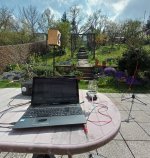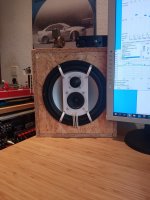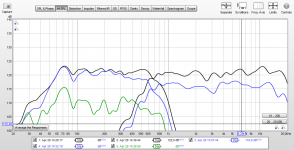Hi to everyone,
i wanted to share a project i was working on for a while. These speakers are a clone of the concept utilised by the german company "ME Geithain", which famously supplies the german state broadcast. The company is located in the former East Germany and the boss Joachim Kiesler was building speakers behind the iron curtain using technologies such as waveguides (RFT BR25/BR50) and line arrays (Geithain ITS50). The first quasi-coaxial speakers (Geithain RL900) also originated back in that time and were first supplied to East german Broadcast and opera houses. These were utilising classic bass-reflex enclosures with the addition of the cardiod version in the early 2000's.
The goal of this project was, to understand the influence of different damping materials as well as port size on the directivity of the woofer.
In the future, i want to compare the quasicoaxial arrangements to more traditional 3-way setups with a large dome and cd-horns.
But first, more about the current setup.
The tweeter is a Dayton ND25-TA which works fine for the job. Seas 27TFFNC/G would probably be better, but i was a cheapskate.
The midrange is a Faital 3fe22 without enclosure but damped with a basotect ring around the rear.
The woofer is a Transfer Audio AR 25. Again Seas L26ROY would be better but i got these for 30€ a piece and they have an xmax of 9,5mm one way.
The crossover is done using EqualizerAPO so there is only one D/A conversion.
Crossover is at 800hz and 3,5khz resulting in the characteristic dip in the directivity index between 3 and 5khz. This will also investigated further. ME Geithain has an in depth understanding of speaker directivity but decides purposfully to put this dip in the directivity index.
the enclosure meassures 33x36x25cm and the rear port equals 135cm² (1/2 Sd) At the moment the damping is archieved by stuffing the eclosure with rockwool but in the future i want to switch to dense polyester damping material. I will post meassurements of the enclosure with and without damping material next week. For the general size, there is a great excel file on Linkwitzlab which calculates the bass roll-off as well as the resonances which occur at the back of the speaker an need to be damped.
i wanted to share a project i was working on for a while. These speakers are a clone of the concept utilised by the german company "ME Geithain", which famously supplies the german state broadcast. The company is located in the former East Germany and the boss Joachim Kiesler was building speakers behind the iron curtain using technologies such as waveguides (RFT BR25/BR50) and line arrays (Geithain ITS50). The first quasi-coaxial speakers (Geithain RL900) also originated back in that time and were first supplied to East german Broadcast and opera houses. These were utilising classic bass-reflex enclosures with the addition of the cardiod version in the early 2000's.
The goal of this project was, to understand the influence of different damping materials as well as port size on the directivity of the woofer.
In the future, i want to compare the quasicoaxial arrangements to more traditional 3-way setups with a large dome and cd-horns.
But first, more about the current setup.
The tweeter is a Dayton ND25-TA which works fine for the job. Seas 27TFFNC/G would probably be better, but i was a cheapskate.
The midrange is a Faital 3fe22 without enclosure but damped with a basotect ring around the rear.
The woofer is a Transfer Audio AR 25. Again Seas L26ROY would be better but i got these for 30€ a piece and they have an xmax of 9,5mm one way.
The crossover is done using EqualizerAPO so there is only one D/A conversion.
Crossover is at 800hz and 3,5khz resulting in the characteristic dip in the directivity index between 3 and 5khz. This will also investigated further. ME Geithain has an in depth understanding of speaker directivity but decides purposfully to put this dip in the directivity index.
the enclosure meassures 33x36x25cm and the rear port equals 135cm² (1/2 Sd) At the moment the damping is archieved by stuffing the eclosure with rockwool but in the future i want to switch to dense polyester damping material. I will post meassurements of the enclosure with and without damping material next week. For the general size, there is a great excel file on Linkwitzlab which calculates the bass roll-off as well as the resonances which occur at the back of the speaker an need to be damped.
Attachments
Thanks lazerluxxer for sharing your work, look fwd to see additional measurements - notably polars - and when conditions alow will share my own. I am experimenting with similar set-ups to achieve constant directivity and carioid’ish behaviour through an active 4 way set-up.
indeed in the treble region hard to get constant directivity without some form of waveguide eg either say a ~12cm coax or separate SEAS dxt / MR combination. On the low-mid range directivity of the woofer may be better addressed by reducing baffle width or using leaky ports at the sides instead of the back and target passive midrange cancellation from ~100-600Hz as achieved by for example the 8C or Sigberg Manta.
i also recall the Geithain is crossed at around ~500Hz which to my assumption was to ensure wavelengths of the woofer remain acoustically large vs the ‘obstruction’ of the quasi-coaxial tweeter/midrange assembly, so interested to see you are crossing somewhat higher. Eager tonsee whether thenpolars would show any ‘discontinuities’ in the 500-900Hz range…?
indeed in the treble region hard to get constant directivity without some form of waveguide eg either say a ~12cm coax or separate SEAS dxt / MR combination. On the low-mid range directivity of the woofer may be better addressed by reducing baffle width or using leaky ports at the sides instead of the back and target passive midrange cancellation from ~100-600Hz as achieved by for example the 8C or Sigberg Manta.
i also recall the Geithain is crossed at around ~500Hz which to my assumption was to ensure wavelengths of the woofer remain acoustically large vs the ‘obstruction’ of the quasi-coaxial tweeter/midrange assembly, so interested to see you are crossing somewhat higher. Eager tonsee whether thenpolars would show any ‘discontinuities’ in the 500-900Hz range…?
good results you don't seem to have issues with the woofer response due to the obstruction. Large radius box corners could help with some of the ripple in the woofers response?
directivity error I can only think of waveguides or coaxials: https://www.bcspeakers.com/en/products/coaxial/4-0/8/4CXN36-8-16 lots of issues with this though, its very deep and also the directivity isn't that constant or monotonic.
directivity error I can only think of waveguides or coaxials: https://www.bcspeakers.com/en/products/coaxial/4-0/8/4CXN36-8-16 lots of issues with this though, its very deep and also the directivity isn't that constant or monotonic.
Thanks for the reply. Unfortunatly i havent looked up how to make polar plotts from meassurements, but I will this winter. I would be really interested in your 4way solution. This system works great in a near-field setting but only for that. For a room one just needs dedicated subwoofers and a cardioid like in the 8c works great because you just need to get down to 100hz or so. I also do think that ports in the sides are better regarding the cardioid behavior. I've also played around with that in another project. The back wall really helps with making the dampening material more efficient. I dont have the meassurements for this system but I was amazed how good it worked as a pa-top. The problem is getting down to 30hz with this approach because a lot of equalization is needed. It is still essentially an open baffle speaker and the path distance between front and rear wave dictates the bass response.Thanks lazerluxxer for sharing your work, look fwd to see additional measurements - notably polars - and when conditions alow will share my own. I am experimenting with similar set-ups to achieve constant directivity and carioid’ish behaviour through an active 4 way set-up.
indeed in the treble region hard to get constant directivity without some form of waveguide eg either say a ~12cm coax or separate SEAS dxt / MR combination. On the low-mid range directivity of the woofer may be better addressed by reducing baffle width or using leaky ports at the sides instead of the back and target passive midrange cancellation from ~100-600Hz as achieved by for example the 8C or Sigberg Manta.
i also recall the Geithain is crossed at around ~500Hz which to my assumption was to ensure wavelengths of the woofer remain acoustically large vs the ‘obstruction’ of the quasi-coaxial tweeter/midrange assembly, so interested to see you are crossing somewhat higher. Eager tonsee whether thenpolars would show any ‘discontinuities’ in the 500-900Hz range…?
Indeed a good coax or something like the midrange in the "Monacor Raduno" is something i'm playing around in my head, but all these approaches are quiet expensive if done well.
Crossover for the 15" geithains is 550hz and 750hz for the 10" which corresponds to the wavelenght. This concept scales quiet nicely with a 15"+5"+1" or a 12"+ 4"+1" or a 10" + 3" +1". The diffraction from the midrange baffle isn't as big of a problem a one would think (or i thought).
Last edited:
Thank you.good results you don't seem to have issues with the woofer response due to the obstruction. Large radius box corners could help with some of the ripple in the woofers response?
directivity error I can only think of waveguides or coaxials: https://www.bcspeakers.com/en/products/coaxial/4-0/8/4CXN36-8-16 lots of issues with this though, its very deep and also the directivity isn't that constant or monotonic.
The ripple in the woofer response stems from the back wave. The radiated response without dampening isnt flat because of the u-frame. There is a great article on linkwitzlab about u-frame and h-frame woofers which goes into detail and explains it a lot better than i am capable of.
The directivity error i mean is intentional but i will elaborate a bit more in my next post.
A couple of months ago i got some Geithain ITS364 speakers with broken foam sorrounds and reconed them. The driver baskets and magnets look like some east German RFT design with a cone similar to the coated papercones by seas. I would guess the manufacturing date to the early to mid 90s.
Geithain still lists similar speakers on their website (TS35K) and i think these are a great design for 90s speakers. Geithain unfotunately doesn't provide the directivity index for their studiomonitors but in these meassurements one can clearly see the typical sounding for Geithain speakers. The dip in the directivity index is a result of the crossover point. This speaker is crossed over a 1900hz and the directivity index corresponds to that. The horn loads way down to 1000hz so a lower crossover point wouldnt be a problem, but geithain purposely choses higher crossover points resulting in this directivity dip.


The meassurements are done outdoors without the protective PA-speaker foam in front of the speaker, so the higher frequencys would be some db lower.
I think the horizontal meassurements are pretty decent for 90s speakers. The biggest advantages imo is the relatively flat response behind the speaker. Rear wall reflections would be neutral which is great, especially for rooms with low dampening. I dont understand why more PA manufacturers use designs like this to decrease sound radiated to the back.
Interestingly, there is a lot of port surface in the rear (2x Sd) and one has a good cardioidish response without slot in the sides. The dampening material is extremely dense tho.

In the vertical meassurements one can clearly see the limits of a system like this. Between 500hz and 2000hz there is a lot of comp filtering going on. This is unavoidable. How big of a problem this is in reality is up to deside for everybody.
Imo it isnt that big of a deal. The summed responses averages out these huge dips and in general vertical reflections arent considered that important. It certainly is a better solution than a simple bassreflex-system whith a omnipole under 1000hz and a monopole over 1000hz.

Geithain still lists similar speakers on their website (TS35K) and i think these are a great design for 90s speakers. Geithain unfotunately doesn't provide the directivity index for their studiomonitors but in these meassurements one can clearly see the typical sounding for Geithain speakers. The dip in the directivity index is a result of the crossover point. This speaker is crossed over a 1900hz and the directivity index corresponds to that. The horn loads way down to 1000hz so a lower crossover point wouldnt be a problem, but geithain purposely choses higher crossover points resulting in this directivity dip.
The meassurements are done outdoors without the protective PA-speaker foam in front of the speaker, so the higher frequencys would be some db lower.
I think the horizontal meassurements are pretty decent for 90s speakers. The biggest advantages imo is the relatively flat response behind the speaker. Rear wall reflections would be neutral which is great, especially for rooms with low dampening. I dont understand why more PA manufacturers use designs like this to decrease sound radiated to the back.
Interestingly, there is a lot of port surface in the rear (2x Sd) and one has a good cardioidish response without slot in the sides. The dampening material is extremely dense tho.
In the vertical meassurements one can clearly see the limits of a system like this. Between 500hz and 2000hz there is a lot of comp filtering going on. This is unavoidable. How big of a problem this is in reality is up to deside for everybody.
Imo it isnt that big of a deal. The summed responses averages out these huge dips and in general vertical reflections arent considered that important. It certainly is a better solution than a simple bassreflex-system whith a omnipole under 1000hz and a monopole over 1000hz.
Last edited:
Thanks for the response. Will share more when I get time to run proper measurements. I am targeting a coaxial (SEAS Prestige 12RE/FXC) in MTM arrangement with two 18cm midbass drivers (likely Seas U18/RNX as I have good experience with its 22cm brother used in the LX521) with passive cardioid applied (leaky side-ports - indeed using the typical calculations regarding distance / open area etc). Similar to your MR I will dampen the back of the coaxial or if needed create a small-proper passive cardioid enclosure. I plan to cross these likely somewhere in the 100-150Hz range as beneath 150 Hz distortion in this pseudo open-baffle arrangement sets in quite rapidly (quite some leads on various fora around the 8c). On the ‘back’ of this front array I will have 2 opposed slot-loaded 7” subwoofer drivers in sealed enclosures. Will be using a FourAudio 4 channel plate-amp which allows for FIR (phase linearisation). My aim is to create an active monitor which delivers near constant directivity from ~100Hz upward - flat response from 20-20KHz with distortion <2% (apart from in the lowest bass region) and notably keep IMD low was well. Have ran some Vituixcad simulations as a proxy and results look exciting. If you are looking for a cheaper coax the SB Acoustics SB12PFC-coax may be one to look for which is just over 50Euros. Haven’t seen polars for this one though….Thanks for the reply. Unfortunatly i havent looked up how to make polar plotts from meassurements, but I will this winter. I would be really interested in your 4way solution. This system works great in a near-field setting but only for that. For a room one just needs dedicated subwoofers and a cardioid like in the 8c works great because you just need to get down to 100hz or so. I also do think that ports in the sides are better regarding the cardioid behavior. I've also played around with that in another project. The back wall really helps with making the dampening material more efficient. I dont have the meassurements for this system but I was amazed how good it worked as a pa-top. The problem is getting down to 30hz with this approach because a lot of equalization is needed. It is still essentially an open baffle speaker and the path distance between front and rear wave dictates the bass response.
View attachment 1114904
Indeed a good coax or something like the midrange in the "Monacor Raduno" is something i'm playing around in my head, but all these approaches are quiet expensive if done well.
Crossover for the 15" geithains is 550hz and 750hz for the 10" which corresponds to the wavelenght. This concept scales quiet nicely with a 15"+5"+1" or a 12"+ 4"+1" or a 10" + 3" +1". The diffraction from the midrange baffle isn't as big of a problem a one would think (or i thought).
- Home
- Loudspeakers
- Multi-Way
- 3-way quasi-coaxial cardioid speaker


